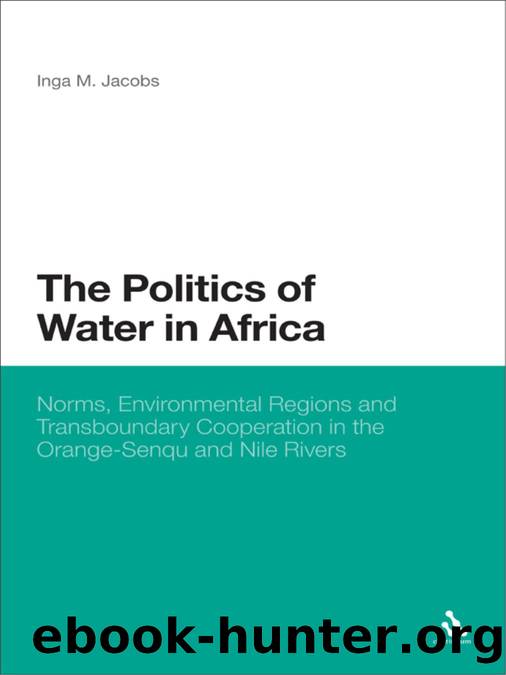The Politics of Water in Africa: Norms, Environmental Regions and Transboundary Cooperation in the Orange-Senqu and Nile Rivers by Inga M Jacobs

Author:Inga M Jacobs [Jacobs, Inga M]
Language: eng
Format: epub
Tags: International Relations, African, Comparative Politics, Arms Control, Political Science, World, General
ISBN: 9781441149688
Google: -qsQiF_V2TQC
Goodreads: 17073656
Publisher: Bloomsbury Academic
Published: 2012-11-02T00:00:00+00:00
Figure 4.1 NBI operational structure
Institutional designs that help or hinder norm convergence at the basin level
While EN-COM is supported by the Eastern Nile Subsidiary Action Programme Technical Team (ENSAPT), NEL-COM is supported by the Nile Equatorial Lakes Technical Advisory Committee (NELTAC) (ibid.). The NBI also comprises of the Technical Advisory Committee (Nile-TAC), which comprises of technical representatives from the member states who report to Nile-COM, and is charged with technical guidance of the NBI (NBI, 2001). Nile-TAC is composed of two senior officials from each member country (ibid.). Finally, a Secretariat (Nile-Sec) is based in Entebbe, Uganda. The Nile-Sec is divided into two investment-oriented Subsidiary Action Programmes that is the Eastern Nile Subsidiary Action Programme (ENSAP) comprising of Egypt, Sudan and Ethiopia; and the Nile Equatorial Lakes Subsidiary Action Programme (NELSAP) comprising of Burundi, DRC, Kenya, Rwanda, Tanzania and Uganda as well as Sudan and Egypt.4 These programmes manage investment projects and ensure that they remain within budget and on schedule (NBI, 2001; Waako, 2008).
The mere existence of multilateral cooperative arrangements is not the only way in which norm convergence is promoted at the basin level. The very institutional design of multilateral arrangements also helps or hinders the way in which actors behave as a collective. The NBI as well as the CFA have both contributed to norm convergence at the basin level.
The NBI and orchestrated norm convergence
By way of its institutional design, the NBI has committed itself to building trust among the riparian countries and promoting cooperative multi-purpose investments in the area of energy and power trade, agriculture, watershed management, information sharing, monitoring and the environment (Waako, 2008). One could also make the argument that the NBI has orchestrated the socialization of specific norms around issue clusters through its Strategic Action Programme (SAP). The SAP has a two-tiered objective: (1) To achieve a shared vision in order to provide a framework for (2) Activities on the ground (NBI, 2001). These ideas/norms are translated into actions through two complementary sub-programmes: (1) Shared Vision Programmes (SVPs), which aim to create a coordination mechanism and âenabling environmentâ for cooperation action; and (2) Subsidiary Action Programmes that plan and implement action on the ground at the lowest appropriate level (NBI, 2001). While the Subsidiary Action Programmes deal with the implementation of investment activities on the ground, which help to realize the shared vision, the SVP relates to ideational and norm convergence at the basin level in order to achieve implementation. Extensive resources have also been put into this process to facilitate collaborative action, exchanges of experiences, trust and capacity building, designed to build a strong foundation for regional cooperation, and thereby defining the type of regional cooperation (through the establishment of agreed upon rules, norms and ideas).
The SVP includes seven thematic projects and one SVP Coordination Project managed by the Nile-Sec. These include projects on water resources, the environment, power trade, agriculture, applied training, communications and stakeholder involvement (NBI, 2001; Waako, 2008). The SVP Coordination Project was created to strengthen the capacity of the NBI institutions.
Download
This site does not store any files on its server. We only index and link to content provided by other sites. Please contact the content providers to delete copyright contents if any and email us, we'll remove relevant links or contents immediately.
| Automotive | Engineering |
| Transportation |
Whiskies Galore by Ian Buxton(41561)
Introduction to Aircraft Design (Cambridge Aerospace Series) by John P. Fielding(32904)
Small Unmanned Fixed-wing Aircraft Design by Andrew J. Keane Andras Sobester James P. Scanlan & András Sóbester & James P. Scanlan(32589)
Craft Beer for the Homebrewer by Michael Agnew(17953)
Turbulence by E. J. Noyes(7733)
The Complete Stick Figure Physics Tutorials by Allen Sarah(7162)
Kaplan MCAT General Chemistry Review by Kaplan(6628)
The Thirst by Nesbo Jo(6473)
Bad Blood by John Carreyrou(6295)
Modelling of Convective Heat and Mass Transfer in Rotating Flows by Igor V. Shevchuk(6244)
Learning SQL by Alan Beaulieu(6056)
Weapons of Math Destruction by Cathy O'Neil(5871)
Man-made Catastrophes and Risk Information Concealment by Dmitry Chernov & Didier Sornette(5687)
Digital Minimalism by Cal Newport;(5416)
Life 3.0: Being Human in the Age of Artificial Intelligence by Tegmark Max(5211)
iGen by Jean M. Twenge(5187)
Secrets of Antigravity Propulsion: Tesla, UFOs, and Classified Aerospace Technology by Ph.D. Paul A. Laviolette(5071)
Design of Trajectory Optimization Approach for Space Maneuver Vehicle Skip Entry Problems by Runqi Chai & Al Savvaris & Antonios Tsourdos & Senchun Chai(4859)
Electronic Devices & Circuits by Jacob Millman & Christos C. Halkias(4766)
